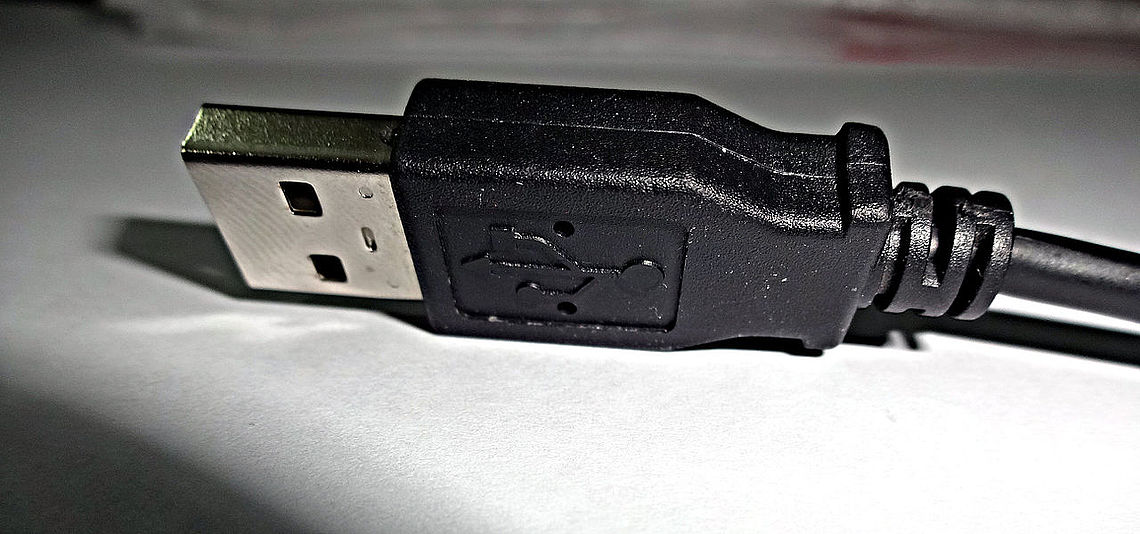USB, short for Universal Serial Bus, is an industry standard developed in the mid-1990s that defines the cables, connectors and communications protocols used in a bus for connection, communication, and power supply between computers and electronic devices. It is currently developed by the USB Implementers Forum.
USB was designed to standardize the connection of computer peripherals (including keyboards, pointing devices, digital cameras, printers, portable media players, disk drives and network adapters) to personal computers, both to communicate and to supply electric power. It has become commonplace on other devices, such as smartphones, PDAs and video game consoles. USB has effectively replaced a variety of earlier interfaces, such as serial and parallel ports, as well as separate power chargers for portable devices.
Overview
In general, there are three basic kinds or sizes related to the USB connectors and types of established connection: the older "standard" size, in its USB 1.1, 2.0, and 3.0 variants (for example, on USB flash drives), the "mini" size (primarily for the B connector end, such as on many cameras), and the "micro" size, in its USB 1.1, 2.0, and 3.0 variants (for example, on most modern mobile phones).
Unlike other data cables (e.g. Ethernet, HDMI), each end of a USB cable uses a different kind of connector; a Type-A or a Type-B. This kind of design was chosen to prevent electrical overloads and damaged equipment, as only the Type-A socket provides power. There are cables with Type-A connectors on both ends, but they should be used carefully. Therefore, in general, each of the different "sizes" requires four different connectors; USB cables have the Type-A and Type-B plugs, and the corresponding receptacles are on the computer or electronic device. In common practice, the Type-A connector is usually the full size, and the Type-B side can vary as needed.
The mini and micro sizes also allow for a reversible Type-AB receptacle, which accepts either a Type-A or a Type-B plug. In this scheme, known as USB On-The-Go, one receptacle performs double duty in space-constrained applications.
Counter-intuitively, the "micro" size is the most durable from the point of designed insertion lifetime. The standard and mini connectors were designed for less than daily connections, with a design lifetime of 1,500 insertion-removal cycles. (Improved mini-B connectors have reached 5,000-cycle lifetimes.) Micro connectors were designed with frequent charging of portable devices in mind; not only is design lifetime of the connector improved to 10,000 cycles, but it was also redesigned to place the flexible contacts, which wear out sooner, on the easily replaced cable, while the more durable rigid contacts are located in the micro-USB receptacles. Likewise, the springy part of the retention mechanism (parts that provide required gripping force) were also moved into plugs on the cable side.
USB connections also come in five data transfer modes, in ascending order: Low Speed, Full Speed, High Speed (2.0), SuperSpeed (3.0), and SuperSpeed+ (3.1). High Speed is supported only by specifically designed USB 2.0 High Speed interfaces (that is, USB 2.0 controllers without the High Speed designation do not support it), as well as by USB 3.0 and newer interfaces. SuperSpeed is supported only by USB 3.0 and newer interfaces, and requires a connector and cable with extra pins and wires, usually distinguishable by the blue inserts in connectors.
History
The basic USB trident logo
USB logo on the head of a standard A plug, the most common USB plug
A group of seven companies began the development of USB in 1994: Compaq, DEC, IBM, Intel, Microsoft, NEC, and Nortel. The goal was to make it fundamentally easier to connect external devices to PCs by replacing the multitude of connectors at the back of PCs, addressing the usability issues of existing interfaces, and simplifying software configuration of all devices connected to USB, as well as permitting greater data rates for external devices. A team including Ajay Bhatt worked on the standard at Intel the first integrated circuits supporting USB were produced by Intel in 1995.
The original USB 1.0 specification, which was introduced in January 1996, defined data transfer rates of 1.5 Mbit/s "Low Speed" and 12 Mbit/s "Full Speed". The first widely used version of USB was 1.1, which was released in September 1998. The 12 Mbit/s data rate was intended for higher-speed devices such as disk drives, and the lower 1.5 Mbit/s rate for low data rate devices such as joysticks. Apple Inc.'s iMac was the first mainstream usage of USB and the iMac's success popularized USB itself. Following Apple's design decision to remove all legacy ports from the iMac, many PC manufactures began building legacy-free PCs, which lead to the broader PC market using USB as a standard.
The USB 2.0 specification was released in April 2000 and was ratified by the USB Implementers Forum (USB-IF) at the end of 2001. Hewlett-Packard, Intel, Lucent Technologies (now Alcatel-Lucent), NEC, and Philips jointly led the initiative to develop a higher data transfer rate, with the resulting specification achieving 480 Mbit/s, a 40-times increase over the original USB 1.1 specification.
The USB 3.0 specification was published on 12 November 2008. Its main goals were to increase the data transfer rate (up to 5 Gbit/s), decrease power consumption, increase power output, and be backward compatible with USB 2.0. USB 3.0 includes a new, higher speed bus called SuperSpeed in parallel with the USB 2.0 bus. For this reason, the new version is also called SuperSpeed. The first USB 3.0 equipped devices were presented in January 2010.
As of 2008, approximately six billion USB ports and interfaces were in the global marketplace, and about two billion were being sold each year.
In December 2014, USB-IF submitted USB 3.1, USB Power Delivery 2.0 and USB Type-C specifications to the IEC (TC 100 – Audio, video and multimedia systems and equipment) for inclusion in the international standard IEC 62680 Universal Serial Bus interfaces for data and power, which is currently based on USB 2.0

